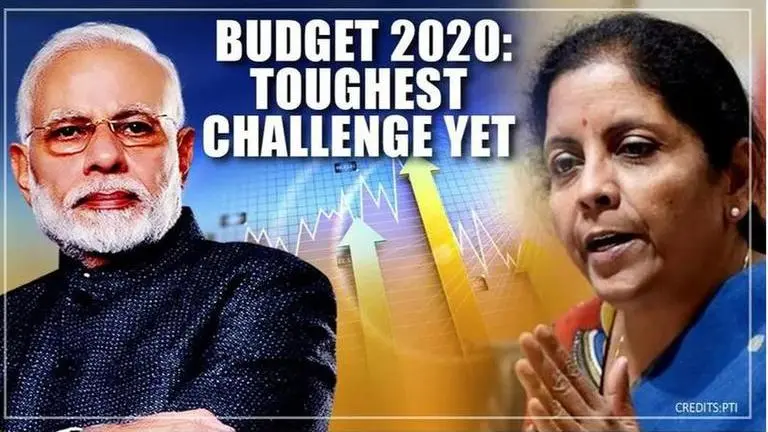Updated 29 January 2020 at 14:36 IST
Budget 2020 the toughest yet for Modi government? Here are its top challenges
Amid India's slowing economic growth, with the country staring 45-year high on unemployment, Finance Minister Nirmala faces Budget 2020 the toughest since 2014
- Republic Business
- 4 min read

Amid India's slowing economic growth, with the country staring 45-year high on unemployment, Union Finance Minister Nirmala faces the toughest Budget since the Modi government came into power. While the key challenge the Finance Minister faces is kickstarting market demand, there are several more hurdles she faces to achieve the impossible target of making India a $ 5 trillion economy. Several market analysts have sought loosening of tax laws to attract investment in India, the Finance Minister has promised a 'pro-people' budget to offset the challenges she faces.
Why 2020 Budget is the toughest one Modi govt faces?
Here are the top challenges:
India's slowing GDP
Marking the slowest growth in almost seven years, India's second-quarter GDP (July-September) numbers stood at 4.5%. This slowdown in growth came inspite of the government's various economic moves like the merger of 9 PSU banks into 4, major corporate tax cuts, policy changes in the automobile sector, reduction in tax regulations to boost foreign income, attract investors and increase the consumer demand. Moreover, the growth prediction set for the next year is at 4.8% while the consulting firm EY estimated that India needed to grow at 9% to reach its $5 trillion target.
Advertisement
Job crisis
According to SBI research report- Ecowrap, the economic slowdown has led to nearly 16 lakh less jobs are projected to be created in 2019-2020 in comparison to 89.7 lakh new jobs in 2018-2019. Moreover, there is a decline in remittances of migrant labourers in Assam, Bihar, Rajasthan, Odisha and UP due to delay in the resolution of cases under bankruptcy proceedings. The report further said in the last five years, the overall productivity growth has remained relatively stagnant between 9.4% to 9.9%, which has in turn led to low wage growth.
Moreover, with the unemployment figures being contested by the Centre, there is severe mistrust among citizens on the numbers released by the Nationals Statistics Office (NSO). Former CEO Arvind Subramanian had claimed that the India’s economic growth rate has been overestimated by around 2.5 percentage points between 2011-12 and 2016-17 due to a change in methodology for calculating GDP, which had led to people wondering whether the current growth rate is at 3%. While the Modi government has rebutted fudging data claims, the Modi government has set up a committee on statistics headed by well-known critic Pronab Sen - in a bid to clean up the statistics system to provide a realistic picture and plan to tackle the job crisis.
Advertisement
Diminishing FDI
Inspite of the Modi government's push for Foreign investments in India, foreign investments hit a decade-low in September 2019 - Foreign Investment to GDP ratio was at 1.1% in 2018-2019, declining by 43% from last year. While efforts have been made by liberalising foreign direct investment rules, the previous budget imposed an additional surcharge on the rich which was then rolled back - but failed to convince investors. FDI since then has picked up according to the Global Investment Trend Monitor report with India attracting $40 billion in investment. This budget will aim at pushing the investment further as UNCTAD expects FDI flows to rise moderately in 2020.
Stagnating market demand, growing inflation
Slumped economic growth has led to twin evils - low demand, high inflation. Experts have stated that the series of bad regulations and internal mismanagement have led to five consecutive months of stagnating domestic demand for goods and services. While the government aims an ambitious target of US $1 trillion in goods and services export by 2024-25, the government also raised import duties on major industrial inputs like steel and aluminum, automobile parts, appliances like camera, television, and smartphones and pulled out of the Regional Comprehensive Economic Partnership. This has hurt India's exports badly and is a challenge that has to be tackled by this budget.
On the other hand, the consumer price index (CPI) rose 7.35% in December, hitting the highest since 2014 - driven by a rise in onion prices. Apart from untimely rains, drought in some regions and crop losses, the government's untimely import policies have led to steady growth in vegetation and pulse prices, state experts. Moreover, the government's high stockpile has kept inflation rising, according to experts, which will have to be tackled by the government as food accounting for two-thirds of their household budgets - which in turn worsens demand.
Published By : Suchitra Karthikeyan
Published On: 29 January 2020 at 14:36 IST
